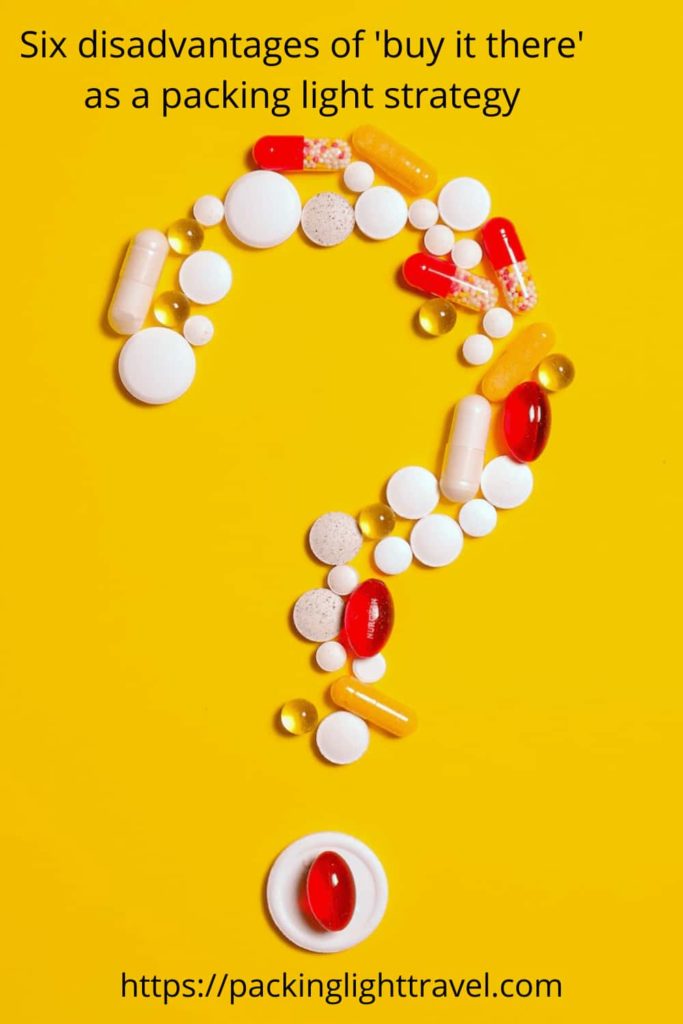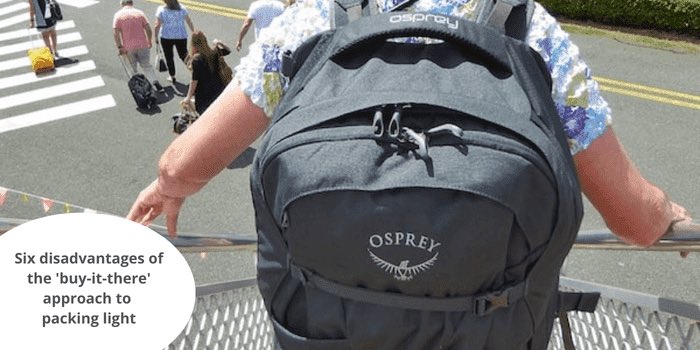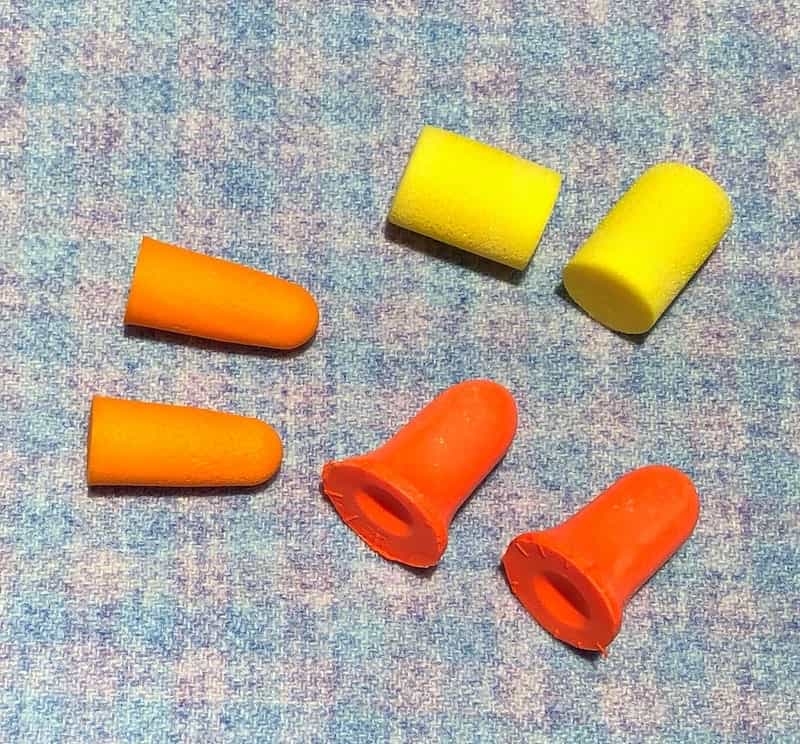Updated April 4, 2022
I’m not a promoter of ‘buy it there’ as a packing light strategy. There may be occasions when buying things at a destination makes sense, but for the most part, I find it’s a strategy with several flaws. Read on for my take on the disadvantages of the buy-it-there approach to packing light.
What does ‘buy it there’ mean as a packing light strategy?
Buy-it-there advocates tend to have similar suggestions. These include:
- Don’t pack primary toiletries and first-aid supplies. Buy them at your destination.
- Forget packing an umbrella or rain gear. Buy it if the weather dictates doing so.
- Do the same with clothing and footwear. Buy a cheap shirt or pair of flip-flops, and toss them when they’re no longer serviceable.
- Pharmacies are in all countries. Get over-the-counter medication at a time if and when it’s needed.
6 Disadvantages of the buy-it-there approach to packing light
Most lists of tips on how to pack light include a reference to buying things at your destination. I can’t entirely agree with the buy-it-there approach for six key reasons:
1. Having access when it’s most needed
In downtown Toronto, I walked out of the North Face store to a stinging sensation in my arm. On closer inspection, I realized I’d been stung by a wasp. Like most travel mishaps, it was totally unexpected. Within seconds, I’d retrieved a sting relief wipe from my small travel first-aid kit and applied it to the bite for almost instant relief.
After a meal in Taipei, the agonizingly uncomfortable sensation of heartburn attacked with a vengeance. In the past, I’ve discovered that a couple of Tums resolve the problem. Were Tums, or something similar, available in Taiwan? It wasn’t a question I needed to ponder while grappling with the debilitating effects of a major case of heartburn. I reached into a pocket of my travel purse, retrieved the roll of Tums, and within a couple of minutes found relief.
In Singapore, a packed travel day was unfolding with my nephew and his friend. My nephew emerged from a public washroom with the distressed look of someone in the throes of travellers’ diarrhea. Reaching into my travel first-aid kit for loperamide pills followed a quick consultation, and we were on our way within minutes.
A sting from a wasp, heartburn, and travellers’ diarrhea rarely strike when one is standing in front of a pharmacy. To complicate matters, how does a person communicate the need for medication to deal with any of these across a language barrier? It’s a challenge to find the appropriate words or body language, type a question into Google Translate, or make a feeble attempt at charades if you’re unwell or in pain.
 Photo by Sora Shimazaki from Pexels
Photo by Sora Shimazaki from Pexels
2. Buying at a destination can consume valuable travel time
There may be occasions when shopping at a destination is an illuminating or entertaining cultural experience. It might become a highlight of the trip, resulting in a story to tell for years to come.
Here’s an example of an experience from Seraina, who blogs at Lost in Switzerland, a site dedicated to helping travellers visit Switzerland on a shoestring budget.
To me, earplugs have become a vital necessity whenever I leave the house. Even if it’s just for one night. The consequences of travelling without them are not pretty.
One time, when I was in Ecuador, I found myself in the unfortunate situation of realizing I’d left my earplugs at the previous hostel. I figured I could go without them for a couple of nights and sort out the issue once I got to Quito. I thought they’d be easier to come by in the capital city.
Wrong thinking! After one night of not being able to block out the usual hostel snorers, I changed my mind. The situation was crying out to be rectified, so I set myself a mission for the next day: Find earplugs in Cuenca.
Sounds easy, right?
Well, it wasn’t. I quickly realized that in South America, not everybody knows what earplugs are. In fact, most people don’t. So here I was, stumbling from one pharmacy to another, trying to explain myself and finding some earplugs. I even had the receptionist at my hostel tell me the word in Spanish to make sure I was asking for the right thing.
The variety of objects I got was downright hilarious. At one pharmacy, they gave me painkillers because they thought I had an ear infection. A little further down the road, they tried to sell me matches (for whatever reason), and just before I was about to give up, a pharmacist nodded understandingly.
He said he knew what I needed, and my heart skipped a beat. I could already see myself enjoying a quiet night while people around me were snoring their heads off.
But I’d cheered too soon. When he came back and handed me a handful of loose tampons, I realized that people in Cuenca clearly didn’t know what earplugs were.
Defeated, frustrated, but very amused by the tampon incident, I headed back to the hostel. When I told my travel friends about this failure of a day, one of them said she had a couple to spare and would love for me to have them. If only I’d known it was that easy.
Undoubtedly, Seraina’s experience is the stuff of a delightful story. However, when time is limited, searching for something that could have easily been packed isn’t the most productive use of valuable travel time.
3. Language and the possibility of making mistakes
Several years ago, I met a traveller from Germany who had come to Australia for a working holiday. When a new friend visited his apartment and dropped something in his rubbish bin, she asked after his cat. The German didn’t have a cat. What was the empty can of cat food doing in the garbage? It was what remained of the German’s previous night’s dinner. His limited grasp of English, questionable cooking skills, and the enticing picture of meat on the can all contributed to his meal of cat food.
Or I can only imagine the scenario behind this post on Facebook, “It’s all fun and games until you try to brush your teeth with denture adhesive.”
You might be certain you’re purchasing the right product, but be unable to read the ingredients, if they’re listed. Not every country requires a detailed listing. In Taiwan, I needed the assistance of an English-speaking Taiwanese friend to help buy insect repellent. Without her, I would have been lost.
How does a traveller ask for anti-diarrhea medication without a common language? According to one Facebook user, “… you haven’t lived until you try to get anti-diarrhea pills in a tiny town in Europe where they don’t speak English. Even an embarrassing game of charades wasn’t helpful, so I walked out with a red face and no pills.”
4. It presumes prices and quality are acceptable
If you’re heading to a sun destination, it’s safe to assume that sunscreen will be readily available. If it’s a resort area, prices may be inflated.
Or, if a tropical climate is on your itinerary, will you be able to purchase insect repellant? Will it be of a quality to afford the necessary protection from mosquito-borne diseases? A cycling trip to Cambodia raised concerns about protection from sunburn, malaria, and dengue fever. It wasn’t in the cards to not pack the most effective sunscreen and insect repellant I could find.
5. What you need may not be available
Anyone who has shopped at UNIQLO has discovered that Japanese standard sizes, even those adapted for UNIQLO stores outside of Japan, run on the small side. Finding larger sizes of clothing and footwear in parts of Asia and South America can be difficult, if not impossible.
Also, it can’t be assumed that because a particular product or favourite brand is available at home, it will be on store shelves at your destination. Packing what you need avoids a possible adverse reaction to something new (or stressing that it might).
6. Buying it there creates a larger environmental footprint
In many spots around the globe, sellers materialize at the first sign of rain with a selection of umbrellas or cheap ponchos. They’re inexpensive, and for the most part, poorly made. Umbrellas tend to be of a size that isn’t travel friendly and worthy of being carried to the next destination. That’s if they survive the winds accompanying rainfall. Take a walk afterwards, and evidence of poorly made casualties will become evident.
 Photo credit: Daniel Trylski from Pexels
Photo credit: Daniel Trylski from Pexels
It’s a similar story with cheap flip-flops that tend to have a short lifespan. I’d much rather invest in a quality pair of Havaianas Slim to use as slippers, shower shoes, and beachwear. Mine have served me well for years.
Along the same lines, I bought a knockoff North Face daypack in Cambodia after discovering our mountain bikes didn’t have any storage to carry a DSLR camera. One of the straps broke on the second day, rendering it useless. Thankfully, our guide said he would give it to his son after the necessary repairs.
Shampoo, sunscreen, and similar products tend to be sold in larger containers, at home and abroad. Leaving behind half-filled containers doesn’t make economic or ecological sense, and passing leftover skin care products to others isn’t a healthy practice. For trips where consumption can be estimated, decanting into smaller, reusable containers is easier on the purse and the environment.
Buying it there might make sense if…
… you’re travelling across markedly different climatic zones. You need cold-weather gear several weeks or months after leaving a warmer climate, and it makes little sense to carry all that dead weight until it’s needed. In those circumstances, second-hand stores can be an excellent source. Or, buy from other travellers who are leaving and eager to unload their gear.
… you’re travelling for longer than your 100 ml of shampoo will see you through. One option is to pack more than one 100-ml container. Another is to pack one or two empty travel-sized containers for decanting between countries. I’ve done that for purchasing sunscreen in New Zealand and decanting what’s left into an empty travel-sized container before flying to Australia.
… your destination has stricter environmental standards governing packaging and ingredients. For example, the European Union bans over one thousand chemicals found in toiletries and cosmetics in other countries. Hawaii bans the sale of over-the-counter sunscreens containing oxybenzone and octinoxate.
If you found this post helpful, please share it by selecting one or more social media buttons. Are you a buy-it-there advocate? If so, when has the approach worked to your advantage? Are there examples when buying it there hasn’t worked to your satisfaction? Please add your thoughts in the comments. Thank you.
Care to pin it for later?








Having to purchase essentials in Istanbul when our suitcase did not make it is a good example of packing those things in your carry-on. However, I wanted to have large containers of sunscreen, deodorant, lotion and toothpaste for a 16-day trip, so I packed these in the suitcase that did not arrive. I learned that what I consider essentials are not as readily available in foreign countries. After spending our touring time looking for these products and finding somewhat acceptable replacements, I have learned to carry more smaller containers in my small ziploc bag in my carry-on and hope they last!
Thank you, Connie, for weighing in. For a 16-day trip, I find I can correctly estimate and pack enough sunscreen, deodorant, lotion, and toothpaste in my two bags (standard carryon and personal carryon) to see me through the trip. It sounds like your smaller containers in your small ziplock bag is the solution.
I agree that there are essentials you don’t want to have to purchase away, if you can avoid it. Go-to pharmaceuticals are things I would never forget to pack (in my many tiny containers purchased just for that purpose). On longer trips, I take precaution to ensure I am carrying a little bit of everything with me on the plane – even in I have packed some in a separate suit case … i.e. pain relief, diarrhea relief, anti-nausea medication, antiseptic & Band-Aids and decongestants which are a must for me, especially when flying. And when traveling with others, I always bring a little more than I need. I have often become the sole supplier of these must-haves, when others forget.
A great way to decant very small amounts of an essential is to use contact lens cases.
I’m more of a “bring your wallet and you’ll be fine” type of minimalist traveler, whereas my wife is much more on the side of bringing with us what we need.
Having tried to hunt down things we desperately need and realizing they just aren’t available (or at least not at all convenient), I’ve been proven wrong in that approach more times than I can count.
My kids and I are grateful to have my wife help us get ready for trips.
I wholeheartedly agree with all you have written! Its one thing I’m always annoyed that is suggested on packing light articles. The other thing is the wasted money. If you already have the stuff at home, don’t waste your valuable vacation funds or time with it at your destination, and hurt the environment.
Wonderful article!